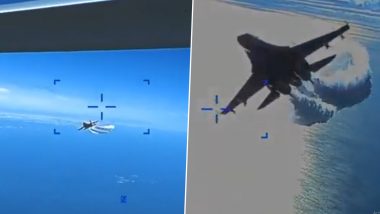Kyiv, March 16: The Pentagon on Thursday released footage of what it said was a Russian aircraft pouring fuel on a U.S. Air Force surveillance drone and clipping the drone's propeller in international airspace over the Black Sea. The 42-second video shows a Russian Su-27 approaching the back of the MQ-9 drone and beginning to release fuel as it passes, the Pentagon said.
Dumping the fuel appeared to be aimed at blinding its optical instruments and driving it out of the area. On a second approach, either the same jet or another Russian fighter that had been shadowing the MQ-9 struck the drone's propeller, damaging one blade, according to the U.S. military. US Drone-Russian Jet Collision: Video Released by United States Shows Moments When Russia's Fighter Aircraft Hit MQ-9 Reaper Drone Over Black Sea.
Watch Video: US Releases Video of Russian Su-27 Jet Dumping Fuel on Its Drone
US releases Video of Russian SU-27 fighter jet colliding with MQ-9 drone pic.twitter.com/IKYBOKYukT
— Amichai Stein (@AmichaiStein1) March 16, 2023
The U.S. military said it ditched the MQ-9 Reaper in the sea after what it described as the Russian fighter making an unsafe intercept of the unmanned aerial vehicle. The video excerpt released by the Pentagon does not show events before or after the apparent fuel-dumping confrontation. US Drone Violated Boundaries of Airspace Regime, Says Russian Defence Ministry.
Russia said its warplanes didn't strike the drone and claimed the unmanned aerial vehicle went down after making a sharp maneuver over the sea. Asked Thursday if Russia would try to recover the drone debris, Kremlin spokesman Dmitry Peskov told reporters the decision was up to the military.
“If they consider it necessary to do so in the Black Sea for the benefit of our interests and our security, they will do it,” he said. Nikolai Patrushev, the secretary of Russia's Security Council, said Wednesday that Moscow would try to recover the drone fragments.
U.S. officials have expressed confidence that nothing of military value would remain from the drone even if Russia managed to retrieve the wreckage. While intercept attempts are not uncommon, the incident amid the war in Ukraine has raised concerns it could bring the United States and Russia closer to a direct conflict.
Moscow has repeatedly voiced concern about U.S. intelligence flights close to the Crimean Peninsula, which Russia seized from Ukraine in 2014 and illegally annexed. The top U.S. and Russian defense and military leaders spoke Wednesday about the encounter over the Black Sea, underscoring its seriousness.
The calls between U.S. Defense Secretary Lloyd Austin, Joint Chiefs of Staff Chairman Gen. Mark Milley, Russian Defense Minister Sergei Shoigu and Gen. Valery Gerasimov, chief of Russian General Staff, were the first since October.
The Russian Defense Ministry said in its report of the call with Austin that Shoigu accused the U.S. of provoking the incident by ignoring flight restrictions the Kremlin had imposed because of its military operations in Ukraine.
The Kremlin argues that by providing weapons to Ukraine and sharing intelligence information with Kyiv, the U.S. and its allies have effectively become engaged in the war, which is now in its 13th month. Russia also blamed “the intensification of intelligence activities against the interests of the Russian Federation,” the Defence Ministry said.
Such U.S. actions “are fraught with escalation of the situation in the Black Sea area,” the ministry said, warning that Moscow “will respond in kind to all provocations.” Sergei Aksenov, the Moscow-appointed head of Crimea, said he thinks Russia should act even more forcefully to put an end the U.S. surveillance flights in the area.
“I personally think that our response in such situations should be tougher,” Aksenov said on his messaging app channel. “We realise that attempted attacks on Crimea have been launched with Americans' guidance. In fact, they are a warring party.”
The MQ-9, which has a 66-foot (20-metre) wingspan, includes a ground control station and satellite equipment. It is capable of carrying munitions, but Air Force Brig. Gen. Pat Ryder, a Pentagon spokesperson, would not say whether the ditched drone had been armed.
Ryder said the incident occurred at 7:03 a.m. Central European time (0603 GMT; 2:03 a.m. EST) over international waters, and well clear of Ukraine, after the Russian jets had flown in the vicinity of the drone for 30 to 40 minutes.
There did not appear to be any communications between the aircraft before the collision, Ryder added. The U.S. has not recovered the crashed drone, U.S. Air Forces-Europe said in a statement, and neither has Russia, Ryder said. Russian officials said Wednesday that they would try to salvage fragments of the MQ-9 from the Black Sea.
U.S. officials have left open the possibility of trying to recover portions of the downed $32 million drone, which they said crashed into waters that were 4,000 to 5,000 feet (1,200 to 1,500 metres) deep. Other U.S. officials said the U.S. does not have military ships in the region likely won't attempt to recover the wreckage.













 Quickly
Quickly


